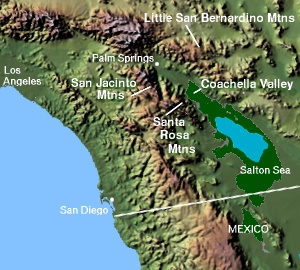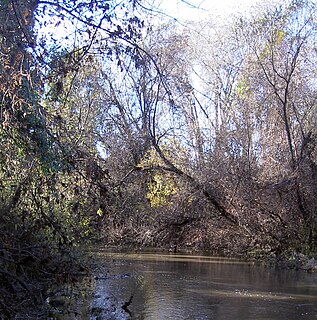
The Humboldt-Toiyabe National Forest (HTNF) is the principal U.S. National Forest in the U.S. state of Nevada, and has a smaller portion in Eastern California. With an area of 6,289,821 acres (25,454.00 km2), it is the largest National Forest of the United States outside Alaska.

The Santa Monica Mountains is a coastal mountain range in Southern California, paralleling the Pacific Ocean. It is part of the Transverse Ranges. Because of its proximity to densely populated regions, it is one of the most visited natural areas in California. Santa Monica Mountains National Recreation Area is located in this mountain range.
Santa Rosa is the Italian, Portuguese and Spanish name for Saint Rose. Santa Rosa may also refer to:

The Transverse Ranges are a group of mountain ranges of southern California, in the Pacific Coast Ranges physiographic region in North America. The Transverse Ranges begin at the southern end of the California Coast Ranges and lie within Santa Barbara, Ventura, Los Angeles, San Bernardino and Riverside counties. The Peninsular Ranges lie to the south. The name Transverse Ranges is due to their east–west orientation, making them transverse to the general northwest–southeast orientation of most of California's coastal mountains.

The Santa Rosa Range is a mountain range in Humboldt County, Nevada, United States. Most of the range is included within the Humboldt-Toiyabe National Forest. The highest peaks in the range are Granite Peak and Santa Rosa Peak. The range extends for approximately 75 miles (120 km) north from Winnemucca Mountain near Winnemucca through eastern Humboldt County to the border with Oregon. The upper elevations of the southern section of the range are protected as the Santa Rosa-Paradise Peak Wilderness Area.

The Santa Ana Mountains are a short peninsular mountain range along the coast of Southern California in the United States. They extend for approximately 61 miles (98 km) southeast of the Los Angeles Basin largely along the border between Orange and Riverside counties.
Santa Rosa Mountains may refer to the following mountains in the United States of America:

The Santa Rosa Mountains are a short mountain range in the Peninsular Ranges system, located east of the Los Angeles Basin and northeast of the San Diego metropolitan area of southern California, in the southwestern United States.

The Santa Rosa and San Jacinto Mountains National Monument is a National Monument in southern California. It includes portions of the Santa Rosa and San Jacinto mountain ranges, the northernmost ones of the Peninsular Ranges system. The national monument covers portions of Riverside County, west of the Coachella Valley, approximately 100 miles (160 km) southeast of downtown Los Angeles.

The Laguna de Santa Rosa is a 22-mile-long (35 km) wetland complex that drains a 254-square-mile (660 km2) watershed encompassing most of the Santa Rosa Plain in Sonoma County, California, United States.

CHRISTUS Santa Rosa Health System, or CHRISTUS Santa Rosa Health Care (CSRHC), is a health care organization in South Texas. Established in 1869, CSRHC is a part of CHRISTUS Health and is the only faith-based, not-for-profit health care system in San Antonio.

Mark West Creek is a 29.9-mile-long (48.1 km) stream that rises in the Mayacamas Mountains of Sonoma County, California, United States. Tributaries of Mark West Creek include Porter Creek and Hummingbird Creek, both of which originate in the same mountain range. Discharge waters of Mark West Creek reach the Russian River after a confluence with the Laguna de Santa Rosa. The Community Clean Water Institute has developed a program for monitoring pollutants in Mark West Creek.

Blucher Creek is a 5.2-mile-long (8.4 km) stream that rises in the hills south of Sebastopol, California, United States, and empties into the Laguna de Santa Rosa.

Mount San Jacinto State Park is in the San Jacinto Mountains, of the Peninsular Ranges system, in Riverside County, California, United States. A majority of the park is within the Santa Rosa and San Jacinto Mountains National Monument. The park is near the Greater Los Angeles and the San Diego metropolitan area.

The Santa Rosa Hills are a mountain range in the Saline Valley the northern Mojave Desert, in Inyo County, California.
Santa Rosa Hills may refer to:

The Santa Rosa Wilderness is a 72,259-acre (292.42 km2) wilderness area in Southern California, in the Santa Rosa Mountains of Riverside and San Diego counties, California. It is in the Colorado Desert section of the Sonoran Desert, above the Coachella Valley and Lower Colorado River Valley regions in a Peninsular Range, between La Quinta to the north and Anza Borrego Desert State Park to the south. The United States Congress established the wilderness in 1984 with the passage of the California Wilderness Act, managed by the both US Forest Service and the Bureau of Land Management. In 2009, the Omnibus Public Land Management Act was signed into law which added more than 2,000 acres (8.1 km2). Most of the Santa Rosa Wilderness is within the Santa Rosa and San Jacinto Mountains National Monument.

Schuchk, also known as Santa Rosa, Santa Rosa Ranch, and Schuchk Ka Wuacho Awotam, is a populated place situated in Pima County, Arizona. It has an estimated elevation of 2,523 feet (769 m) above sea level. The name is derived from the Tohono O'odham scuck, which means "black ones", referring to black hills.


















